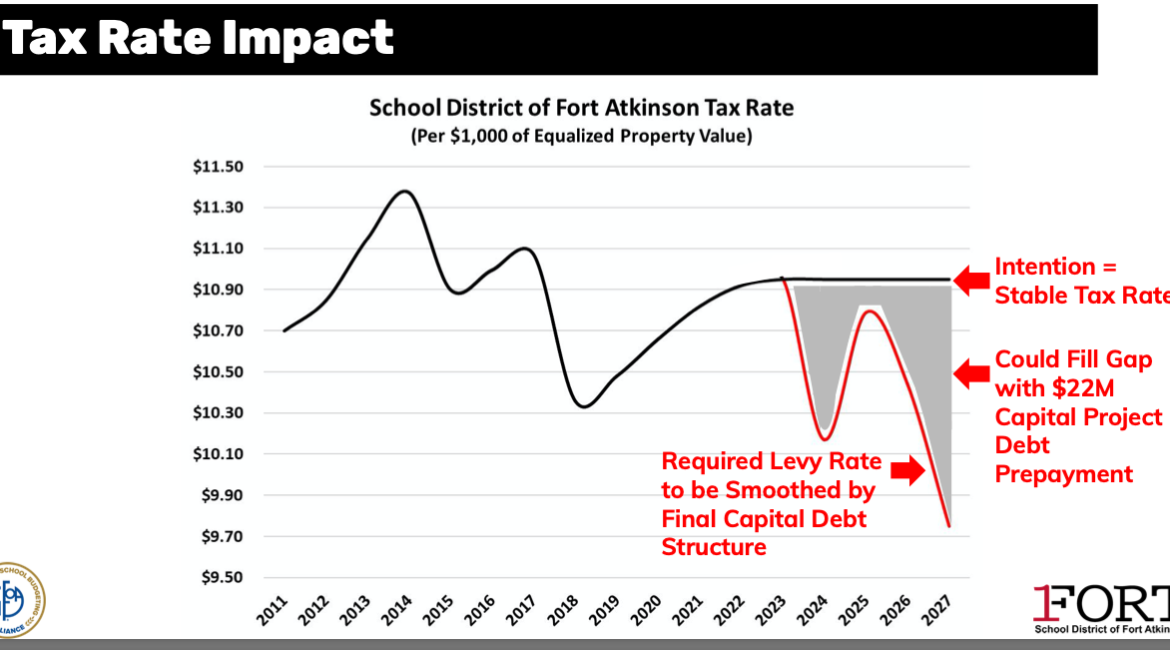By Kim McDarison
The School District of Fort Atkinson Board of Eduction Tuesday approved a two-part $8 million operational referendum question for placement on the April 4 general election ballot.
Board members approved “Option A,” one of two options presented which, as outlined by Director of Business Services Jason Demerath, will, if approved by voters in April, allow the district to collect from its taxpayers $3 million on a recurring basis beginning in the 2023-24 school year and $5 million on a nonrecurring basis for each year within a four-year period, beginning with the 2023-24 school year and ending with the 2026-27 school year, for a total of $8 million above the state-imposed revenue cap in each of the four school years.
A second option, “Option B,” which offered the same four-year period and structure, but with reversed amounts — $5 million in recurring and $3 million in non-recurring dollars — was presented as an alternative.
During discussion, board members were in unanimous support of Option A.
“My feeling on this is … I always come back to the consistency of a number, so the $3 million Option A strikes well with me, said board president Kori Knickrehm.
“I would like B, but I think we have a better chance of getting A through,” said board member Chris Rogers.
“I think that’s pretty consistent, I mean we all really do want B because that will help out tremendously later on, but I don’t think now would be a good time for it,” board member Amy Reynolds said, adding that the consistency with Options A “would be a better choice.”
Board member Rhona Buchta asked: But ultimately the two of them, I mean it’s the same amount, or the tax rate is the same? It’s just more what the numbers look like?”
Board members agreed that Buchta’s understanding of the two options was correct.
Aided by slides, Demerath, on Tuesday, provided information about the district’s budget process and the value and structure of the two options.
Several of the slides were earlier included in a presentation given to board members during their meeting in December.
An earlier story about the proposed referendum, including the December presentation, is here: https://fortatkinsononline.com/school-board-weighs-options-for-april-ballot-placement-of-operational-referendum/.
Demerath began Tuesday’s presentation by asking: “Why does the district need to consider an operational referendum?”
He said the answer to the question revolved around the district’ previously approved $3 million operational referendum which sunsets this school year. That, coupled with the district’s unsuccessful ask of the voters for an operational referendum last November, the district’s declining enrollment, the “lack of any state allowable revenue increases, and the upcoming loss of one-time federal funding,” while the district simultaneously faces inflationary impacts and an increasingly competitive labor market, creates a condition which he described as a “looming fiscal cliff.”
Demerath said funds achieved through a successful operational referendum question were required to meet the district’s strategic goals and service the community.
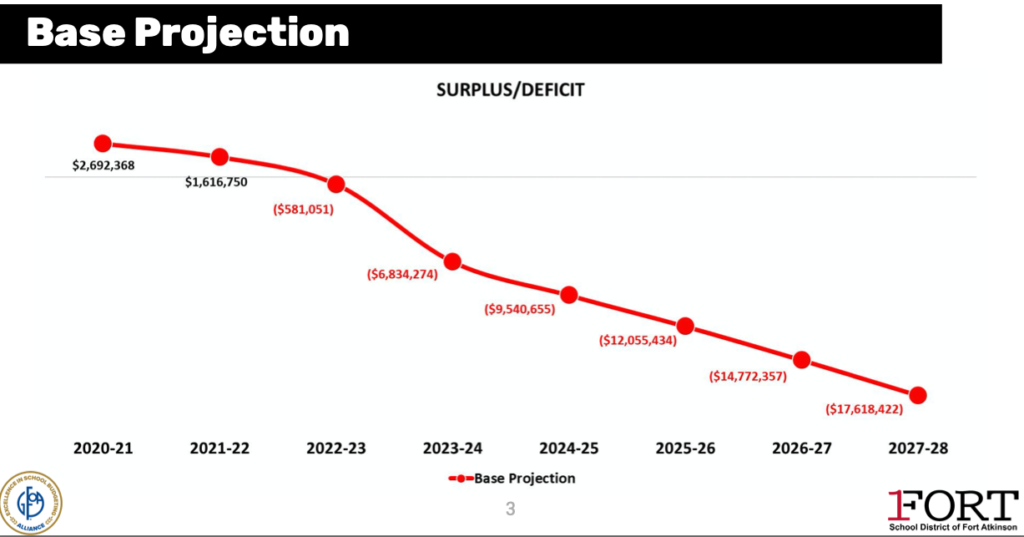
Pointing to a slide titled: Base Projection, shown above, Demerath said the district’s projected deficit for next year is “nearing $7 million.”
Looking at the current year, he said, the budgeted deficit is approximately $600,000, “even with the current $3 million referendum funds and $1.15 million in one-time federal COVID relief funds. This means that if these two one-time fund sources didn’t exist this year, our deficit would be about $4.75 million.”
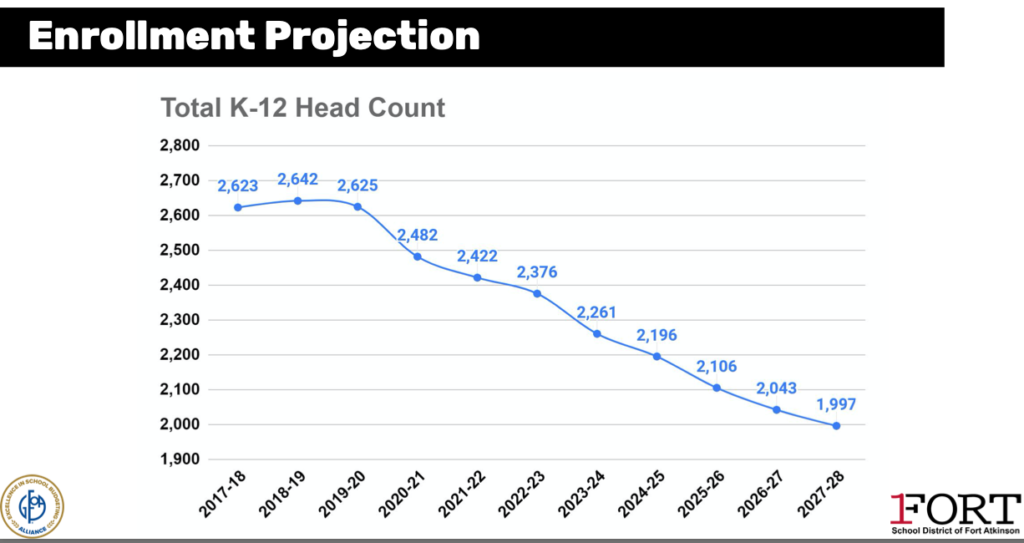
Sharing a slide titled: “Total K-12 Head Count,” shown above, Demerath said that state funding was tied to enrollment.
“As enrollment declines, so do our resources. While we have been having the ongoing conversation about right-sizing our staff to match these enrollment declines, including the attrition of seven positions coming into the current school year, with no allowable revenue increases, even that right-sizing can’t keep up with the fast decline of our operational resources and increasing expenses,” he said.
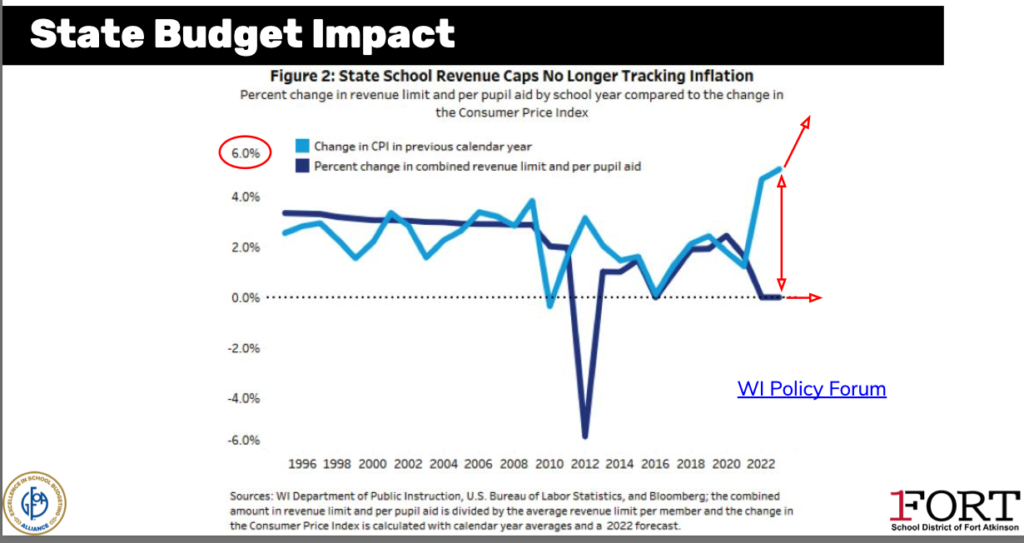
Demerath next pointed to a slide titled: “State Budget Impact,” shown above, which, he said, illustrated the impact to the district’s budget when the state, over the course of its biennial budget, does not allow revenue increases and inflation rates, illustrated using the Consumer Price Index (CPI), continue to climb.
Said Demerath: “The state CPI increases are directly linked to employee compensation as under state law a certified bargaining unit can only negotiate wage increases up to CPI.
“We’ve also made an effort to align our compensation increases with that CPI increase to ensure we can attract and retain quality 1Fort team members by allowing our compensation to keep up with increasing prices and remain competitive.”
Demerath pointed to a series of red arrows within the graph, which, he said, indicated the gap between CPI and the effects of no allowable revenue increase as dictated by the state.
“Over the course of this two-year state budget, the CPI has increased 5.93% with no allowable revenue increase. Just last week it was determined that CPI for ’23-’24 will be 8.01%,” he said.

Sharing a slide indicating the potential for a $200 increase in per pupil aid, shown above, Demerath noted that such an increase over each of the next two years would do little to offset the impact inflation.
“While $200 per pupil each year for two years might sound like a lot, given no increase at all in the last two years, as noted (on the graph) that’s only a 1.11% increase in revenue over the current year, while inflation is at 8%.
“A much larger increase from the state would be needed to make any significant positive changes to this projection. With the state sitting on a nearly $7 billion surplus going into the next state budget, we’re hopeful, but it’s hard to be too optimistic about what funding might come to public schools in the next state budget,” he said.
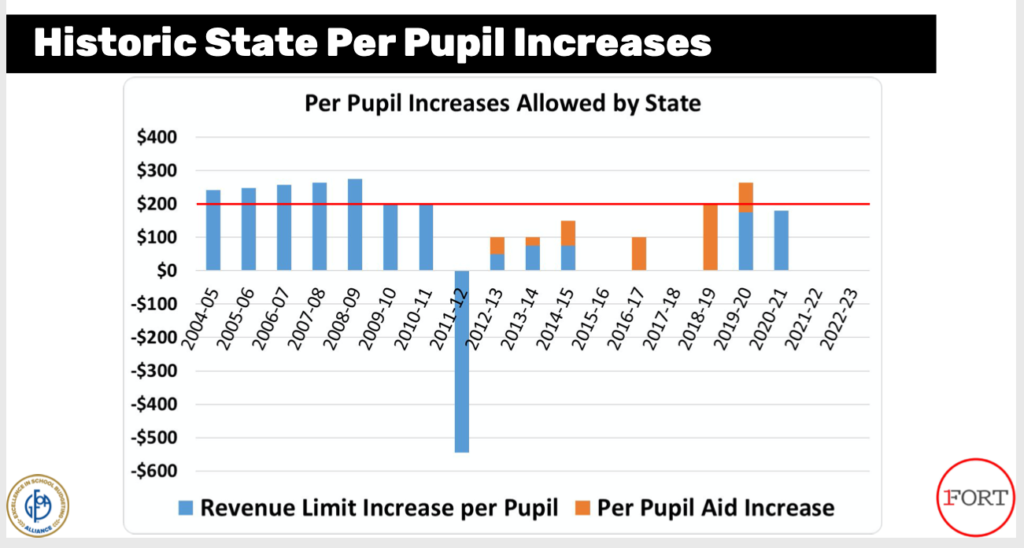
A slide, as shown above, indicted the history of per pupil aid over a 19-year period as granted by the state.
“As you can see, only once in the last 14 years the per pupil increase granted by the state exceeded $200. So we are hopeful, but not necessarily optimistic about the state funding us with the nearly $7 billion surplus they have right now,” Demerath said.
Loss of federal funding
Demerath noted the impact of the loss of the one-time federal COVID Elementary and Secondary School Emergency Relief (ESSER) funds.
“This was meant to fill the gap left by the lack of state funding, which is what we decided to use it for,” he said, adding that in the current school year’s budget, the district has included $1.15 million of that funding to help offset that lack of state funding.
“We have one more year of about $750,000 of this funding available, and then it disappears, adding to the fiscal cliff we’re facing,” Demerath said.
Lessons from November
Demerath said that the unsuccessful operational referendum in November had provided the district with an opportunity to learn.
Among lessons, he said, the district learned that the complicated nature of the referendum question may have been a contributing factor to its failure to pass. The district learned that a next operational referendum question should be simplified, he said.
Additionally, two referendum questions on a single ballot added to the complexity, he said, noting that in April, the district would bring one question with one focus.
Further, he said, “the board had a conversation last month that pointed toward the desire to see more recurring funding as part of any solution, and that having more recurring funding would provide some future financial stability, although the board was unsure exactly how that might look and what it might mean for the ballot question.”
The board’s indication that it wanted to consider a question with more recurring funding prompted the creation of the two referendum options shared Tuesday, Demerath said.
Comparing the two options
Comparing the two options, Demerath said Option A — offering a combination question with $3 million recurring and $5 million non-recurring for four years — would create a situation whereby the district could fund budgets through the ’26-’27 school year, but would have a total cumulative deficit of $5 million from 2020 to 2027.
“This would mean that we would have four years to address that $5 million through attritions, strategic abandonments, and/or new revenue from the state over the next two state budgets above and beyond the $200 per pupil (funding),” he said.
Option B, as compared with Option A, would “flip” the recurring and nonrecurring amounts.
“Because the total amount is the same, we end up with the same cumulative deficit in this option as with Option A. So again, the same total of $8 million for the referendum, but more of the funding is recurring in this option. Between the two, the only difference is what happens in the fifth year (2027-28) after the nonrecurring portion expires.”
Slides indicated that, under Option B, the district would have a smaller funding gap to close by approximately $2 million.
According to Demerath, both options would be achieved without a tax rate increase to property owners.
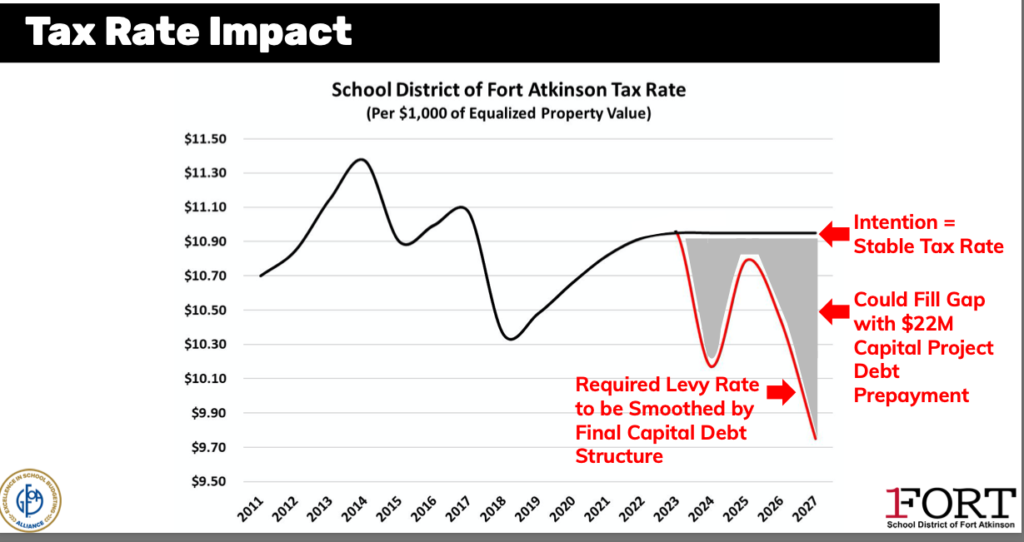
Pointing to a slide, shown above, Demerath said the district’s intension would be to “continue a stable tax rate over the course of this referendum.”
A black line on the graph, he said, represented the district’s intention, while the red line illustrated a projected tax rate under both scenarios.
While the line indicated that overall the tax rate would decrease, Demerath said it also showed some “turbulence,” which, he noted, “would be smoothed out as we set the final capital debt structure for the $22 million capital referendum that was successful in November. So in the end it may look like a gradual decline.”
According to Demerath, the outcome indicated by the graph could be achieved by a board decision to potentially prepay capital debt, as economic circumstances might allow, each year over the course of the next four years.
While Demerath stated that both options requested the same total amount of $8 million collected over the same four-year period of the non-recurring component, neither would result in a “permanent fix.”
“Unless funding mechanisms change at the state level, and get to a place where annual allowable revenue increases are aligned with annual inflationary expense increases, the district will continue to have to come back to the electorate with an operational referendum,” he said.
He added: “Both can be achieved using the same tax rate for the next four years. Tax rate stability is achieved through debt management.”
In conclusion, Demerath said that the April ballot provided a final opportunity to bring an operational referendum question before voters to fund the 2023-24 school year.
“Our next opportunity for an operational referendum will not be until next spring. Without this proposed referendum, it’s estimated that next year’s deficit will be approximately $6.8 million,” he said.
While he described Option A as the more familiar and conservative approach, he said: “Option B leaves us with less to come back for in the future.”
On the ballot
With the board’s approval Tuesday of Option A, voters heading to the polls in April will find the following question on the ballot:
The question that will appear on the April 4 ballot will read as follows: “Be it resolved by the School Board of the School District of Fort Atkinson, Jefferson and Rock counties, Wisconsin, that the final school district budget beginning with the 2023-24 school year shall include amounts not to exceed $3,000,000 each year (on a recurring basis) and $5,000,000 each year (on a non-recurring basis for a period of four years through the 2026-27 school year) in excess of the revenue limited imposed by Section 121.91 of the Wisconsin statutes for the purpose of paying district costs.”
This post has already been read 1486 times!
